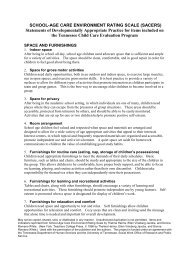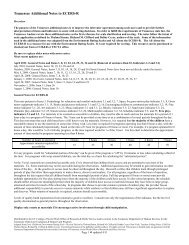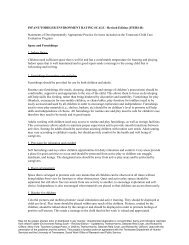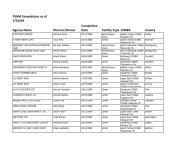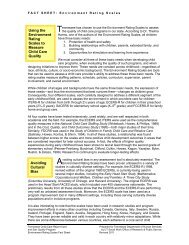ECERS-R - Star-Quality Program
ECERS-R - Star-Quality Program
ECERS-R - Star-Quality Program
You also want an ePaper? Increase the reach of your titles
YUMPU automatically turns print PDFs into web optimized ePapers that Google loves.
INTERACTIONS<br />
29. Supervision of gross motor activities<br />
Caregivers should use gross motor activities as learning opportunities to promote positive social<br />
interactions and to encourage the development of skills and new experiences Diligent supervision of<br />
gross motor activities, whether indoors or outdoors, is critical to preventing accidents and insuring<br />
safe, active play.<br />
30. General supervision of children (other than gross motor)<br />
During activities, caregivers must balance the level of supervision and control based upon the ages,<br />
abilities, and individual needs of the children. Adequate supervision and awareness of the whole<br />
group is required for children’s health and safety and in the recognition of accomplishments, which is<br />
necessary for children’s emotional well-being.<br />
31. Discipline<br />
The set-up of the environment, teacher expectations, available materials and opportunities, and daily<br />
schedule significantly impacts children’s behavior in childcare. A classroom and curriculum geared<br />
toward developmentally appropriate practice will lead to generally good behavior that is the product of<br />
self-motivation rather than the result of punishment and control.<br />
32. Staff-child interactions<br />
Caregivers, who are nurturing and responsive, promote the development of mutual respect between<br />
children and adults. Children, who trust adults to provide for their physical, psychological, and<br />
emotional needs, develop their own sense of self-worth and self-esteem.<br />
33. Interactions among children<br />
Because self-regulation, proper emotional expression, and positive social relationships are such<br />
essential skills for later schooling and life, teachers must encourage children to develop acceptable<br />
behaviors by providing a setting that encourages real opportunities for initiative taking and<br />
competence building. Providing opportunities for children to work and play together, to solve<br />
conflicts in productive ways, and to participate in group activities are ways teachers promote positive<br />
social relationships.<br />
PROGRAM STRUCTURE<br />
34. Schedule<br />
Children thrive on having a consistent routine that provides a balance of activities designed to meet<br />
individual needs and foster physical, cognitive, social, and emotional growth. Best practice promotes<br />
a daily schedule with large amounts of time for play, smooth transitions between activities, and a<br />
balance between child-initiated and teacher-directed activities.<br />
May not be copied, shared, sold, or distributed in any manner. Unauthorized duplication is not permitted.<br />
Items and indicators reprinted from Early Childhood Environment Rating Scale – Revised Edition – Updated<br />
by Thelma Harms, Richard M. Clifford, and Debby Cryer. (New York: Teachers College Press, 2005 by<br />
Thelma Harms, Richard M. Clifford, and Debby Cryer.) Used with the permission of the publisher and the<br />
authors. This project is funded under an agreement with the Tennessee Department of Human Services<br />
and the University of Tennessee, Social Work Office of Research and Public Service.




